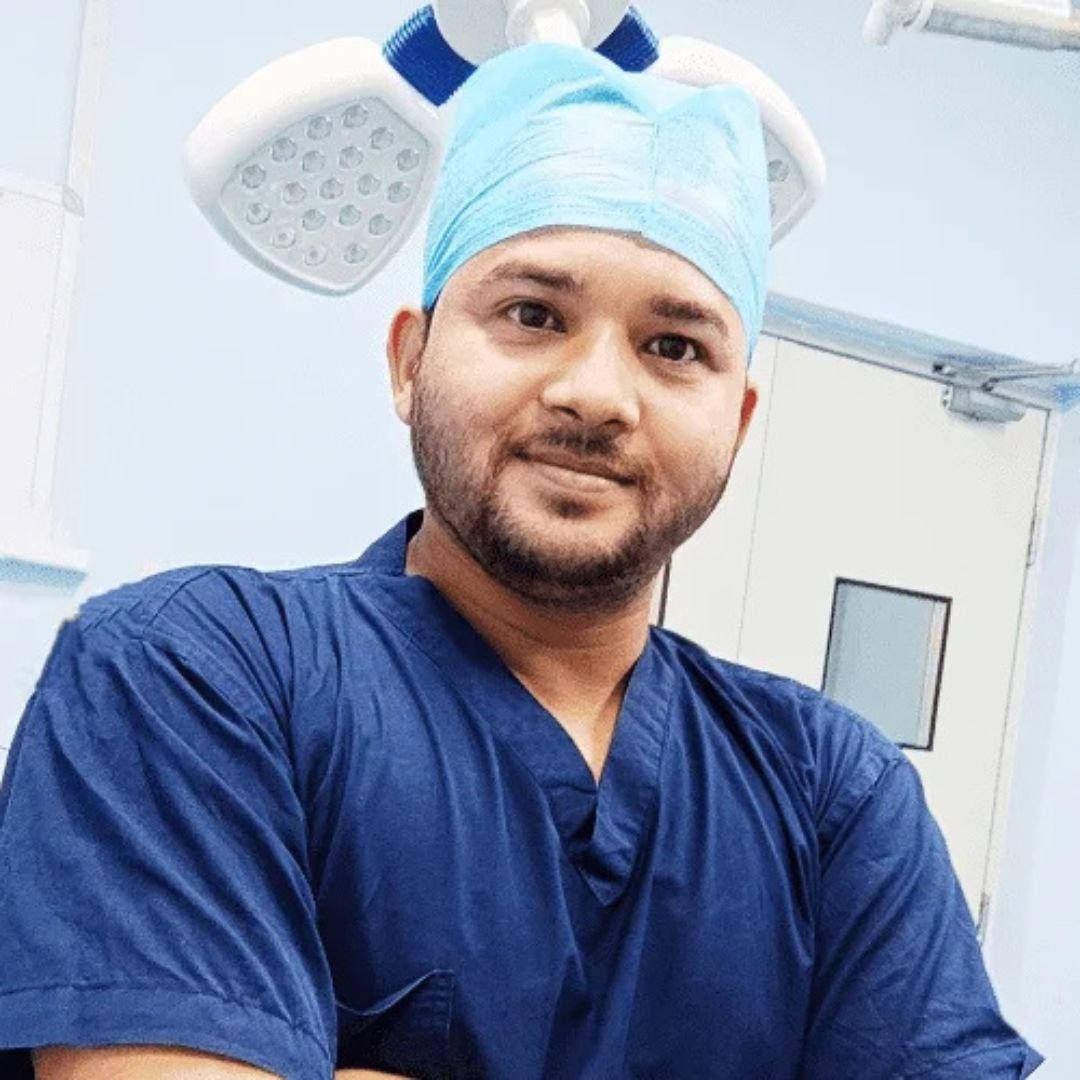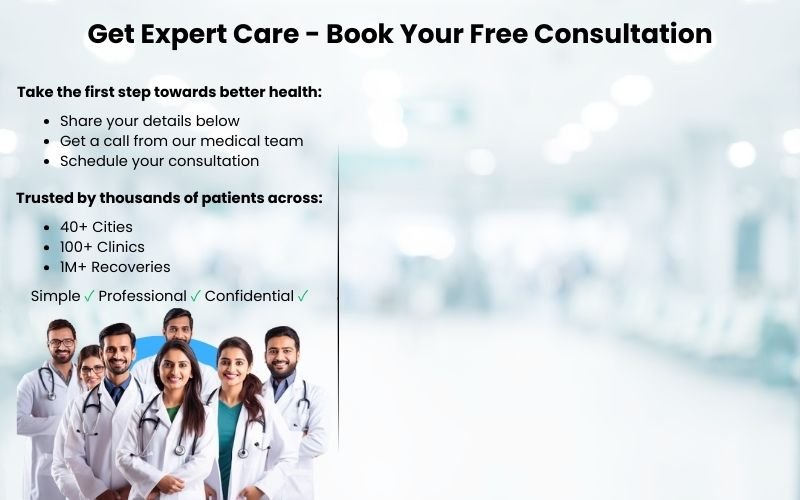Deep Vein Thrombosis (DVT) Treatment
Deep Vein Thrombosis (DVT) is a serious vascular condition where blood clots form in deep veins, typically in the legs. Unlike varicose veins, which are often a cosmetic concern or cause mild discomfort, DVT can lead to life-threatening complications like pulmonary embolism if untreated. Treatment focuses on preventing clot growth and reducing risks, often involving anticoagulants (blood thinners), thrombolytic therapy for severe cases, or surgical interventions like thrombectomy. Compression stockings may also be used to improve blood flow. It’s crucial to differentiate between varicose veins and DVT, as the latter requires immediate, specialized care from deep vein thrombosis specialists to ensure effective management and prevent serious outcomes.
Book Appointments With Our Expert Doctors Near You
- Get consultation for 50+ diseases across India
- In-person and online consultation with experienced doctors
- Extensive medical assistance throughout your treatment


Dr Ashish Sachdeva
MBBS, MS - General Surgery, General Surgeon, Bariatric Surgeon, Laparoscopic Surgeon
4.9/5
20 Years Experience
Vadodara, India

Dr. Tanmay Jain
General Surgeon, Laparoscopic Surgeon and Proctologist
4.9/5
12 Years Experience
Jaipur, India

Dr. Vikram Vasuniya
MBBS, MS (General Surgery) General Laparoscopic & Laser Surgeon, Laser Proctologist
4.9/5
14 Years Experience
Bhopal, India

Dr. Sujeet Kumar Bharti
MBBS, MS (General Surgery) General Laparoscopic & Laser Surgeon, Laser Proctologist
4.9/5
22 Years Experience
Patna, India
What is Deep Vein Thrombosis (DVT)?
Deep Vein Thrombosis (DVT) is a serious medical condition where a blood clot forms in one or more of the deep veins in the body, usually in the legs. Unlike superficial vein issues like varicose veins, DVT can lead to life-threatening complications if the clot breaks loose and travels to the lungs, causing a pulmonary embolism. Recognizing the deep vein thrombosis symptoms early is crucial for timely intervention. Symptoms often include swelling, pain, redness, and warmth in the affected area. If you experience these signs, it’s essential to consult a deep vein thrombosis doctor immediately.
DVT can occur due to prolonged immobility, surgery, injury, or underlying medical conditions that affect blood clotting. Understanding the difference between deep vein thrombosis vs varicose veins is vital, as the two conditions require entirely different approaches to treatment. While varicose veins are often treated with laser therapy, DVT demands a comprehensive treatment plan that may include medication, lifestyle changes, and in some cases, surgical intervention.
Deep Vein Thrombosis Symptoms: What to Look Out For
Recognizing the deep vein thrombosis symptoms early can make a significant difference in the outcome of the condition. Common symptoms include:
- Swelling in the affected leg, often starting in the calf.
- Pain or tenderness in the leg, which may feel like a cramp or soreness.
- Red or discolored skin on the leg.
- A feeling of warmth in the affected area.
In some cases, DVT may not present any noticeable symptoms, making it a silent but dangerous condition. This is why individuals with risk factors such as a family history of blood clots, obesity, or recent surgery should be particularly vigilant. If you suspect you may have DVT, it’s crucial to seek immediate medical attention from deep vein thrombosis specialists who can provide an accurate diagnosis and appropriate treatment.
Deep Vein Thrombosis Treatment: What Are Your Options?
The goal of deep vein thrombosis treatment is to prevent the clot from growing larger, breaking loose, and causing further complications. Treatment options vary depending on the severity of the condition and the patient’s overall health. Common approaches include:
- Anticoagulant Medications: Often referred to as blood thinners, these medications help prevent new clots from forming and stop existing clots from growing larger.
- Thrombolytics: In severe cases, clot-dissolving medications may be used to break up the clot quickly.
- Compression Stockings: These specialized stockings help reduce swelling and improve blood flow in the legs.
- Surgical Interventions: In rare cases, procedures like thrombectomy or the insertion of a vena cava filter may be necessary.
It’s important to note that deep vein thrombosis treatment is highly personalized. A deep vein thrombosis doctor will evaluate your condition and recommend the best course of action based on your specific needs.
Deep Vein Thrombosis in India: Why Choose Bharatkare?
India has emerged as a leading destination for advanced medical treatments, including deep vein thrombosis treatment. With state-of-the-art facilities and highly skilled deep vein thrombosis specialists, patients can expect world-class care at a fraction of the cost compared to other countries. At Bharatkare, we pride ourselves on offering comprehensive care for DVT patients, from accurate diagnosis to personalized treatment plans.
Our team of experienced deep vein thrombosis doctors is equipped with the latest technology and follows international protocols to ensure the best possible outcomes. Whether you’re seeking treatment for deep vein thrombosis symptoms or looking for a second opinion, Bharatkare is your trusted partner in vascular health.
Deep Vein Thrombosis vs Varicose Veins: Understanding the Difference
While both deep vein thrombosis and varicose veins affect the veins, they are fundamentally different conditions. Varicose veins are swollen, twisted veins that are visible just under the surface of the skin, often causing discomfort but rarely posing serious health risks. On the other hand, deep vein thrombosis involves blood clots in the deep veins, which can lead to severe complications if not treated promptly.
Understanding the distinction between deep vein thrombosis vs varicose veins is crucial for receiving the right treatment. While laser therapy may be effective for varicose veins, DVT requires a more specialized approach. If you’re unsure about your symptoms, consult a deep vein thrombosis specialist for a thorough evaluation.
What Happens During Deep Vein Thrombosis (DVT) Diagnosis?
Accurate diagnosis is the first step toward effective deep vein thrombosis treatment. When you visit a deep vein thrombosis specialist, they will begin with a thorough physical examination and review of your medical history. To confirm the presence of a blood clot, the following diagnostic tests may be recommended:
- Ultrasound: The most common test for DVT, an ultrasound uses sound waves to create images of blood flow in the veins and detect clots.
- D-Dimer Test: This blood test measures a substance released when a blood clot breaks up. Elevated levels may indicate the presence of DVT.
- Venography: In rare cases, a dye is injected into the veins, and X-rays are taken to visualize blood flow and identify clots.
- MRI or CT Scan: These imaging tests provide detailed pictures of the veins and are used when ultrasound results are inconclusive.
Early and accurate diagnosis is critical to prevent complications like pulmonary embolism. If you’re experiencing deep vein thrombosis symptoms, don’t delay seeking help from a deep vein thrombosis doctor.
How to Prepare for Deep Vein Thrombosis (DVT) Treatment
Preparing for deep vein thrombosis treatment involves both physical and mental readiness. Here’s what you can expect:
- Medical Evaluation: Your deep vein thrombosis specialist will conduct a comprehensive evaluation to determine the best treatment plan for your condition.
- Medication Review: Inform your doctor about any medications or supplements you’re taking, as some may need to be adjusted before treatment.
- Lifestyle Adjustments: Your doctor may recommend lifestyle changes, such as increasing physical activity or wearing compression stockings, to improve blood flow.
- Mental Preparation: Understanding the treatment process and its potential outcomes can help alleviate anxiety. Feel free to ask your doctor any questions you may have.
At Bharatkare, our team of deep vein thrombosis doctors ensures that you’re fully prepared for your treatment journey, providing guidance and support every step of the way.
What to Expect After Deep Vein Thrombosis (DVT) Treatment
Recovery from deep vein thrombosis treatment varies depending on the severity of the condition and the type of treatment received. Here’s what you can expect:
- Immediate Post-Treatment Care: If you’ve undergone a procedure or started medication, your doctor will monitor your condition closely to ensure there are no complications.
- Medication Management: Blood thinners or other medications may be prescribed for several months to prevent new clots from forming.
- Follow-Up Appointments: Regular check-ups with your deep vein thrombosis specialist are essential to monitor your progress and adjust your treatment plan if needed.
- Lifestyle Changes: Incorporating healthy habits like regular exercise, a balanced diet, and avoiding prolonged immobility can significantly reduce the risk of recurrence.
Recovery is a gradual process, and it’s important to follow your doctor’s instructions carefully. At Bharatkare, we provide personalized post-treatment care to help you regain your health and prevent future complications.
When is Deep Vein Thrombosis (DVT) Treatment Required?
Deep vein thrombosis treatment is necessary when a blood clot is detected in the deep veins, as untreated DVT can lead to serious complications like pulmonary embolism, chronic venous insufficiency, or post-thrombotic syndrome. Treatment is particularly urgent if you’re experiencing severe deep vein thrombosis symptoms such as:
- Sudden swelling or pain in the leg.
- Difficulty breathing or chest pain, which may indicate a pulmonary embolism.
- Skin discoloration or ulcers in the affected area.
If you have risk factors such as a history of blood clots, recent surgery, or prolonged immobility, it’s important to consult a deep vein thrombosis doctor for preventive measures. Early intervention can save lives and improve long-term outcomes.
What Are the Benefits of Deep Vein Thrombosis (DVT) Treatment?
Seeking timely deep vein thrombosis treatment offers numerous benefits, including:
- Prevention of Life-Threatening Complications: Treatment reduces the risk of pulmonary embolism, a potentially fatal condition.
- Improved Quality of Life: Alleviating symptoms like pain and swelling allows you to resume your daily activities with ease.
- Reduced Risk of Recurrence: Proper treatment and follow-up care significantly lower the chances of future blood clots.
- Personalized Care: With the guidance of deep vein thrombosis specialists, you receive a treatment plan tailored to your unique needs.
At Bharatkare, we’re committed to providing comprehensive care that addresses both the immediate and long-term aspects of DVT.
Recovery Tips After Deep Vein Thrombosis (DVT) Treatment
Recovering from deep vein thrombosis treatment requires a proactive approach to ensure optimal healing and prevent recurrence. Here are some expert-recommended tips:
- Stay Active: Gentle exercises like walking can improve blood circulation and prevent new clots from forming.
- Wear Compression Stockings: These specialized garments help reduce swelling and improve blood flow in the legs.
- Follow Medication Guidelines: Take prescribed medications as directed by your deep vein thrombosis doctor to prevent complications.
- Stay Hydrated: Drinking plenty of water helps maintain healthy blood viscosity.
- Avoid Prolonged Immobility: If you have a sedentary job, take regular breaks to stretch and move around.
By following these tips and staying in close contact with your deep vein thrombosis specialist, you can ensure a smooth recovery and reduce the risk of future issues.
What is the Role of a Deep Vein Thrombosis Specialist?
A deep vein thrombosis specialist is a medical professional with advanced training in diagnosing and treating vascular conditions, particularly DVT. Their role is critical in ensuring accurate diagnosis, effective treatment, and long-term management of the condition. Here’s what you can expect when consulting a deep vein thrombosis doctor:
- Comprehensive Evaluation: They will assess your symptoms, medical history, and risk factors to determine the likelihood of DVT.
- Advanced Diagnostics: Using state-of-the-art tools like ultrasound and blood tests, they can confirm the presence of a blood clot.
- Personalized Treatment Plans: Based on your condition, they will recommend the most appropriate deep vein thrombosis treatment, whether it’s medication, lifestyle changes, or surgical intervention.
- Ongoing Monitoring: Regular follow-ups ensure that your treatment is effective and adjusted as needed.
At Bharatkare, our team of deep vein thrombosis specialists is dedicated to providing compassionate, patient-centered care that addresses your unique needs.
How Does Deep Vein Thrombosis (DVT) Affect Daily Life?
Living with deep vein thrombosis can significantly impact your daily life, especially if symptoms like pain, swelling, and fatigue are present. Here’s how DVT may affect you:
- Physical Limitations: Swelling and pain in the legs can make it difficult to walk or stand for long periods.
- Emotional Stress: The fear of complications like pulmonary embolism can cause anxiety and stress.
- Lifestyle Adjustments: You may need to make changes like wearing compression stockings, taking medications, and avoiding prolonged immobility.
- Work and Social Life: Severe symptoms may require time off work or limit your ability to participate in social activities.
However, with proper deep vein thrombosis treatment and guidance from a deep vein thrombosis doctor, you can manage these challenges effectively and regain your quality of life.
What Are the Risk Factors for Deep Vein Thrombosis (DVT)?
Understanding the risk factors for deep vein thrombosis is crucial for prevention and early detection. Some of the most common risk factors include:
- Prolonged Immobility: Long periods of sitting, such as during travel or recovery from surgery, can increase the risk of blood clots.
- Medical Conditions: Conditions like cancer, heart disease, and inflammatory disorders can elevate the risk of DVT.
- Family History: A genetic predisposition to blood clotting disorders can make you more susceptible.
- Age and Obesity: Older adults and individuals with a higher body mass index (BMI) are at greater risk.
- Pregnancy and Hormonal Therapy: Hormonal changes can affect blood clotting, increasing the risk of DVT.
If you have one or more of these risk factors, it’s important to consult a deep vein thrombosis specialist for preventive measures and regular monitoring.
How is Deep Vein Thrombosis (DVT) Treated in India?
India has become a global hub for advanced medical treatments, including deep vein thrombosis treatment. Here’s why patients choose India for DVT care:
- World-Class Facilities: Hospitals in India are equipped with cutting-edge technology for accurate diagnosis and effective treatment.
- Expert Specialists: The country boasts a pool of highly skilled deep vein thrombosis doctors with extensive experience in managing complex cases.
- Cost-Effective Care: Compared to Western countries, deep vein thrombosis treatment in India is significantly more affordable without compromising on quality.
- Holistic Approach: Indian healthcare providers emphasize a comprehensive approach, combining medical treatment with lifestyle modifications for long-term success.
At Bharatkare, we leverage these advantages to provide exceptional care for patients seeking deep vein thrombosis treatment in India.
What Are the Long-Term Effects of Untreated Deep Vein Thrombosis (DVT)?
Failing to seek timely deep vein thrombosis treatment can lead to severe long-term consequences, including:
- Pulmonary Embolism: A life-threatening condition where a blood clot travels to the lungs, blocking blood flow.
- Post-Thrombotic Syndrome: Chronic pain, swelling, and skin ulcers caused by damaged veins.
- Chronic Venous Insufficiency: Impaired blood flow in the affected veins, leading to persistent discomfort and mobility issues.
- Recurrent Clots: Untreated DVT increases the risk of future blood clots, requiring more aggressive treatment.
To avoid these complications, it’s essential to consult a deep vein thrombosis specialist at the first sign of symptoms. Early intervention can prevent long-term damage and improve your overall health.
How Can You Prevent Deep Vein Thrombosis (DVT)?
Prevention is always better than cure, especially when it comes to deep vein thrombosis. Here are some practical steps to reduce your risk:
- Stay Active: Regular exercise improves blood circulation and reduces the risk of clots.
- Maintain a Healthy Weight: Obesity is a significant risk factor for DVT, so adopting a balanced diet and exercise routine can help.
- Avoid Prolonged Immobility: If you have a desk job or are traveling long distances, take breaks to stretch and move around.
- Stay Hydrated: Drinking plenty of water helps maintain healthy blood viscosity.
- Follow Medical Advice: If you’re at high risk, your deep vein thrombosis doctor may recommend preventive medications or compression stockings.
By incorporating these habits into your daily life, you can significantly lower your risk of developing DVT.
What Are the Latest Advances in Deep Vein Thrombosis (DVT) Treatment?
The field of deep vein thrombosis treatment has seen significant advancements in recent years, offering patients more effective and less invasive options. Here are some of the latest innovations:
- Catheter-Directed Thrombolysis: This minimally invasive procedure involves inserting a catheter to deliver clot-dissolving medication directly to the affected vein, reducing the risk of bleeding complications.
- Mechanical Thrombectomy: Advanced devices are used to physically remove blood clots, offering a quicker resolution for severe cases of DVT.
- Newer Anticoagulants: Medications like direct oral anticoagulants (DOACs) provide effective clot prevention with fewer side effects and no need for frequent monitoring.
- Wearable Technology: Devices like smart compression stockings and mobile health apps help patients monitor their condition and adhere to treatment plans.
These advancements, combined with the expertise of deep vein thrombosis specialists, ensure that patients receive the most up-to-date and effective care. At Bharatkare, we stay at the forefront of these innovations to provide the best possible outcomes for our patients.
How Does Deep Vein Thrombosis (DVT) Impact Pregnancy?
Pregnancy increases the risk of deep vein thrombosis due to hormonal changes, increased pressure on the veins, and reduced mobility. Here’s how DVT can affect pregnant women:
- Higher Risk of Complications: Pregnant women with DVT are at greater risk of developing pulmonary embolism, which can be life-threatening for both the mother and the baby.
- Challenges in Diagnosis: Symptoms like leg swelling and discomfort are common during pregnancy, making it difficult to distinguish between normal changes and DVT.
- Specialized Treatment: Pregnant women require tailored deep vein thrombosis treatment to ensure the safety of both mother and child. Blood thinners like low-molecular-weight heparin are often preferred due to their safety profile.
If you’re pregnant and experiencing deep vein thrombosis symptoms, it’s crucial to consult a deep vein thrombosis doctor who specializes in managing DVT during pregnancy.
What Are the Myths and Facts About Deep Vein Thrombosis (DVT)?
There are many misconceptions about deep vein thrombosis that can lead to delayed diagnosis and treatment. Let’s debunk some common myths:
- Myth: Only older adults get DVT.
Fact: While age is a risk factor, DVT can affect individuals of any age, especially those with risk factors like obesity, pregnancy, or a sedentary lifestyle. - Myth: DVT is not a serious condition.
Fact: Untreated DVT can lead to life-threatening complications like pulmonary embolism and chronic venous insufficiency. - Myth: You can’t prevent DVT.
Fact: Lifestyle changes like regular exercise, maintaining a healthy weight, and avoiding prolonged immobility can significantly reduce your risk. - Myth: DVT only affects the legs.
Fact: While DVT most commonly occurs in the legs, it can also develop in other parts of the body, such as the arms or pelvis.
Understanding the facts about DVT is essential for timely diagnosis and effective treatment. If you have concerns, consult a deep vein thrombosis specialist for accurate information and guidance.
How Does Deep Vein Thrombosis (DVT) Affect Travelers?
Long-distance travel, especially by air, is a well-known risk factor for deep vein thrombosis due to prolonged immobility. This condition is often referred to as “economy class syndrome.” Here’s how travelers can reduce their risk:
- Stay Hydrated: Dehydration thickens the blood, increasing the risk of clots. Drink plenty of water before and during your journey.
- Move Regularly: Take breaks to walk around and stretch your legs, especially during long flights or car rides.
- Wear Compression Stockings: These garments improve blood flow and reduce the risk of DVT during travel.
- Perform Leg Exercises: Simple exercises like ankle rotations and calf raises can help maintain circulation.
If you’re planning a long trip and have risk factors for DVT, consult a deep vein thrombosis doctor for personalized advice and preventive measures.
What Are the Psychological Effects of Deep Vein Thrombosis (DVT)?
Living with deep vein thrombosis can take a toll on your mental health, especially if you’re dealing with chronic symptoms or the fear of complications. Here’s how DVT can affect your psychological well-being:
- Anxiety and Stress: The fear of developing pulmonary embolism or recurrent clots can cause significant anxiety.
- Depression: Chronic pain, mobility issues, and lifestyle changes may lead to feelings of sadness or hopelessness.
- Social Isolation: Severe symptoms may limit your ability to participate in social activities, leading to feelings of loneliness.
Addressing the psychological effects of DVT is an essential part of comprehensive care. At Bharatkare, our deep vein thrombosis specialists provide not only medical treatment but also emotional support to help you cope with the challenges of living with DVT.
How Can Family and Friends Support Someone with Deep Vein Thrombosis (DVT)?
Support from loved ones plays a crucial role in the recovery and management of deep vein thrombosis. Here’s how family and friends can help:
- Encourage Medical Care: Remind the patient to attend follow-up appointments and adhere to their treatment plan.
- Provide Emotional Support: Be patient and understanding, as living with DVT can be emotionally challenging.
- Assist with Lifestyle Changes: Help the patient incorporate healthy habits like regular exercise and a balanced diet.
- Educate Themselves: Learn about DVT to better understand the condition and provide informed support.
By working together, patients and their support networks can navigate the challenges of DVT more effectively.
Key Takeaways
- Early Detection is Crucial: Recognizing deep vein thrombosis symptoms and seeking prompt medical care can prevent life-threatening complications.
- Specialized Care Matters: Consulting a deep vein thrombosis specialist ensures accurate diagnosis and personalized treatment.
- Lifestyle Plays a Role: Maintaining a healthy weight, staying active, and avoiding prolonged immobility can significantly reduce your risk of DVT.
- India is a Leading Destination: With world-class facilities and affordable costs, deep vein thrombosis treatment in India is an excellent choice for patients worldwide.
- Comprehensive Care is Essential: Effective DVT management involves not only medical treatment but also emotional support and lifestyle adjustments.
FAQ
You Can Find All Answers Here
Early deep vein thrombosis symptoms include swelling, pain, redness, and warmth in the affected leg. However, some cases may not show noticeable symptoms, making regular check-ups essential for high-risk individuals.
While both conditions affect the veins, deep vein thrombosis vs varicose veins differ significantly. Varicose veins are superficial and rarely dangerous, whereas DVT involves blood clots in deep veins, which can lead to life-threatening complications like pulmonary embolism
With timely and appropriate deep vein thrombosis treatment, most patients recover fully. However, long-term management, including medication and lifestyle changes, may be necessary to prevent recurrence.
Yes, India is a leading destination for deep vein thrombosis treatment, offering advanced medical facilities and highly skilled deep vein thrombosis specialists at affordable costs.
Travel is possible after DVT treatment, but it’s essential to take precautions like wearing compression stockings, staying hydrated, and moving regularly during long journeys. Consult your deep vein thrombosis doctor for personalized advice.
If you experience deep vein thrombosis symptoms, seek immediate medical attention. Early diagnosis and treatment are crucial to prevent complications.
Quick Links
Popular Surgeries
Find Us
© Copyright BharatKare 2025. All Right Reserved.



